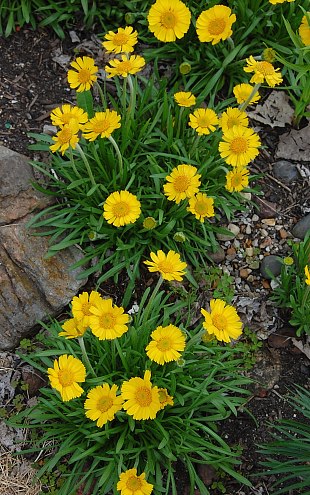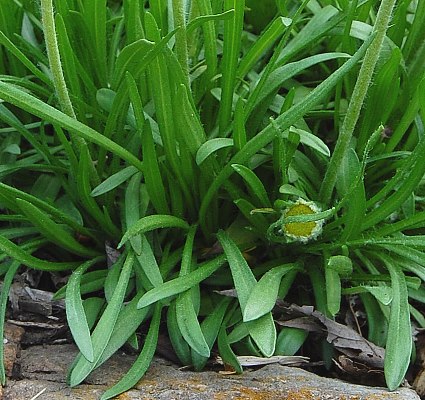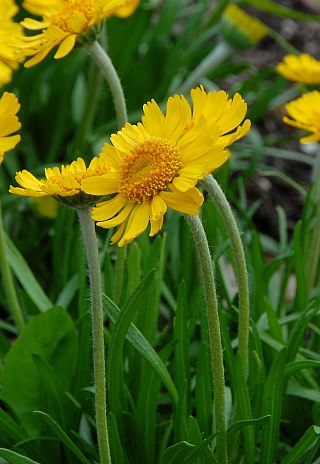Description:
This
perennial wildflower consists of a rosette, or clustered rosettes, of
basal leaves from which one or more flowering stalks develop. The
ascending to spreading basal leaves are 1-6" long and 1/8–1/2" (3-12
mm.) across; they are dark
green,
linear-oblanceolate in shape, smooth along their margins, and mostly
hairless. The leaves of plants that are under stress from drought may
become grayish green. Individual flowerheads develop at the apex of
unbranched stalks that are 4-12" high; these flowering stalks are more
or less erect. The stalks are rather stout and more or less finely
pubescent. Individual flowerheads span 1-1¾" across, consisting of
10-30 ray florets that surround a dense cluster of 50 or more disk
florets. The petal-like rays of the ray florets are ¼–¾" long, bright
yellow, oblong in shape, and divided into 3 blunt teeth at their tips.
The tiny disk florets are golden yellow, tubular in shape, and lobed
along their upper rims. Both ray and disk florets are fertile. Around
the base of each flowerhead, there are green floral bracts (phyllaries)
in 2-3 series. Individual floral bracts are about ¼" in length, finely
pubescent, and oblong-ovate with rounded tips. The blooming period
usually occurs from late spring to early summer. A colony of plants may
bloom for about a month. The florets are replaced by small achenes that
are angular and finely pubescent; they become mature during the summer.
At the apex of each achene, there is a tiny crown of 5 or more chaffy
scales that are lanceolate in shape. The achenes are distributed by
gravity and wind, although they usually don't travel far from the
mother plant. The root system consists of a short stout caudex that
eventually branches, forming a cluster of plants from vegetative
offsets.
dark
green,
linear-oblanceolate in shape, smooth along their margins, and mostly
hairless. The leaves of plants that are under stress from drought may
become grayish green. Individual flowerheads develop at the apex of
unbranched stalks that are 4-12" high; these flowering stalks are more
or less erect. The stalks are rather stout and more or less finely
pubescent. Individual flowerheads span 1-1¾" across, consisting of
10-30 ray florets that surround a dense cluster of 50 or more disk
florets. The petal-like rays of the ray florets are ¼–¾" long, bright
yellow, oblong in shape, and divided into 3 blunt teeth at their tips.
The tiny disk florets are golden yellow, tubular in shape, and lobed
along their upper rims. Both ray and disk florets are fertile. Around
the base of each flowerhead, there are green floral bracts (phyllaries)
in 2-3 series. Individual floral bracts are about ¼" in length, finely
pubescent, and oblong-ovate with rounded tips. The blooming period
usually occurs from late spring to early summer. A colony of plants may
bloom for about a month. The florets are replaced by small achenes that
are angular and finely pubescent; they become mature during the summer.
At the apex of each achene, there is a tiny crown of 5 or more chaffy
scales that are lanceolate in shape. The achenes are distributed by
gravity and wind, although they usually don't travel far from the
mother plant. The root system consists of a short stout caudex that
eventually branches, forming a cluster of plants from vegetative
offsets.
Cultivation:
The preference is full sun, well-drained mesic to dry conditions, and a
gritty alkaline soil containing gravel or rocky material. This
wildflower can be cultivated in rock gardens. The seeds require no
winter dormancy and should be sowed during the same year that they are
produced.
Range & Habitat:
Lakeside Daisy is a rare native wildflower in Illinois, having been
found in only Tazewell and Will counties (see Distribution
Map). It is state-listed as 'endangered' and federally listed
as 'threatened.' At one time, this wildflower was extirpated from the
wild in Illinois, although it still existed in private gardens in the
Chicago area. More recently, it has been successfully reintroduced in
various natural areas of the state. The largest population in the
United States exists in Marblehead Peninsula along Lake Erie in Ohio.
Habitats consist of dry dolomite prairies and gravel prairies, gravelly
hill prairies, sand-gravel terraces along major rivers, ledges along
cliffs, and limestone quarries. This wildflower is found in rocky areas
with sparse vegetation and can tolerate minor amounts of disturbance.

Faunal
Associations:
Both nectar and pollen are available from the flowerheads, which
attract bees, flies, beetles, butterflies, and skippers. Floral bee
visitors include bumblebees, small carpenter bees (Ceratina
spp.), and Halictid bees. Cross-pollination is required
because individual plants are genetically self-incompatible. Insects
that feed on the Lakeside Daisy include grasshoppers and the larvae of
an unidentified weevil; the latter feeds on the seeds. The flowering
stalks are eaten occasionally by the White-Tailed Deer and Cottontail
Rabbit. In the Western states, related species in the Hymenoxys/Tetraneuris
complex are known to have toxic leaves that can poison cattle and
sheep, however the toxicity of the more eastern Lakeside Daisy has not
been determined.
Photographic Location:
A botanical garden in the Chicago area. The photographs of the Lakeside
Daisy were taken by Jim Ault (Copyright © 2010).

Comments: The Lakeside Daisy is an attractive plant. This wildflower is rare because of its restrictive habitat requirements and the limited distribution of its seeds. Lakeside Daisy is one of several spring-blooming species in the Aster family that have yellow flowerheads and rosettes of basal leaves. It can be distinguished from these other species by its narrow dark green leaves, unbranched flowering stalks, three-toothed rays, and achenes with tiny crowns of scales (rather than a tufts of hairs). Other closely related species exist in the Western states. The Lakeside Daisy is sometimes classified as var. glabra of the western Hymenoxys acaulis. However, this latter species differs by having fewer ray florets (less than 15), floral bracts (phyllaries) with awned pointed tips, and basal leaves that are gray-green with silky hairs.